Gerry Adams's Blog, page 72
October 24, 2012
Irish Homeless World Cup Team visits the Dáil
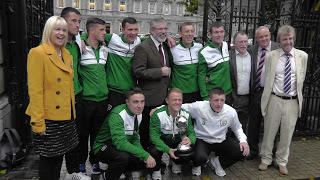
I have to admit that I have never heard a lot about the Homeless World Cup. Have you? But that changed for me on Tuesday when the Irish team that participated recently in Mexico City visited the Dáil for an event hosted by two Sinn Féin TDs Sandra McLellan and Desi Ellis.
From late September through to this month over 700 homeless men and women, representing 59 teams, arrived in Mexico City from 55 countries around the world. The tournament has a competition for men and one for women. It ran over nine days between the 6th and 14th of October. It was won by Chile who beat Mexico 8-5. The Mexican women’s team won their competition defeating Brazil 6-2.

The competition was held on a field constructed in the Zocalo. This is the historic main plaza or square in the heart of the City. The Zocalo has been a focal point of gathering for people since the time of the Aztecs.
The Homeless World Cup was founded 11 years ago in 2001. It draws support from tens of thousands of homeless people and NGOs (non governmental organisations) around the globe and seeks through sport to motivate and encourage homeless people to see beyond their difficulties. Its objective is to raise awareness around issues of homelessness, poverty and inequality.
This year the Irish team came in a credible 16th out of the 54 teams participating. The Irish team came in ahead of other European squads like Germany and Holland and England. It also saw David Byrne win the individual goalkeeper of the tournament award.
Regrettably the tournament did not receive the attention in the Irish media that it deserves. But elsewhere, including in Mexico where as many as 50,000 spectators turned up for some of the matches, there was extensive coverage.
The organisers have set themselves the goal of involving one million people across the world in 100 nations in the next two years. The Irish team was drawn from Street League teams participating in the all-Ireland tournament in Dublin. Street league was established in 2005, although the first Irish team took part in the Homeless World Cup in Austria in 2003.
The homeless magazine Big Issue was the driving force behind the establishment of Street Leagues across the island and there are now street leagues in Cork and Galway and Waterford, Portlaoise, Belfast and elsewhere.
Hundreds of young people are involved and a variety of tournaments are run throughout the year culminating in the all-Ireland Tournament in Dublin. The young people who participate are homeless, or drug and alcohol dependent individuals in rehabilitation, or ex-offenders, the long term unemployed with identified learning disabilities, or refugee and asylum seekers.
The purpose behind the Street Leagues is to build self-esteem, and self-confidence, and to provide the young people with the basic tools necessary to help them in the future.Sean Kavanagh from Irish Street Leagues has expressed concern about the future of the project in an environment where there is less money being raised to run the program. He pointed out that in the south it takes about ‘€80,000 to keep someone in prison for a year. If I had that regular income along with the money we raise from fundraising activities I could secure the future of the leagues and just think for a moment, if only one of the many lads participating in the leagues turned his life around, just think of the benefits to him, his family, friends and the community.’
The Street League is an inspirational programme. It and all those who make it possible, deserves our support and thanks for the great work they do.
The reception in Leinster House was attended by Minister Michael Ring. Following an intervention by Sandra he agreed to meet Sean Kavanagh to discuss the issue of future funding.
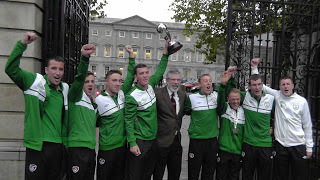
As Desi Ellis said the Minister also needs to consider hosting the Homeless World Cup. Such an event would mark a real commitment. It would be an initiative that would build confidence and lift the morale of homeless people everywhere. It would also be a major tourist event. And a world cup that we could win.
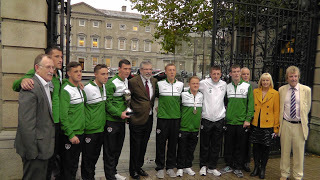
Published on October 24, 2012 01:31
October 23, 2012
Targeting the vulnerable – Cutting Home Help support
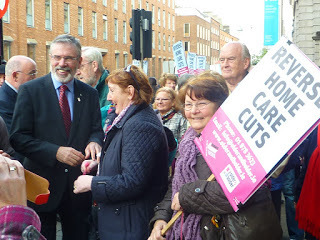 There is an 80 year old partially sighted woman living just outside Drogheda who recently had a hip replacement operation. Consequently she has limited mobility. The Health Service Executive allocated her a home help package of 30 minutes a week!
There is an 80 year old partially sighted woman living just outside Drogheda who recently had a hip replacement operation. Consequently she has limited mobility. The Health Service Executive allocated her a home help package of 30 minutes a week!Last Thursday I met with older citizens outside the Dáil who were there with the group ‘Older & Bolder’, which is an NGO committed to defending the rights of the elderly. They were lobbying for the immediate reversal of government cuts to Home Help and Home Care Packages. Many of those participating were older citizens dependent on their home help service and worried and angry and distressed at the government’s plans.
The Director of Older & Bolder Patricia Conboy, warned that the government’s cuts “ will devastate the prospect of safe and healthy ageing at home. They actually contradict government policy of supporting people to age safely at home.”
The government’s attitude to the provision of home helps reflects Fine Gael and Labour’s general approach to dealing with the economic crisis. It is to heap the burden of paying for the banking debt onto the shoulders of those who can least afford it and to impose cuts to public services which disproportionately affect our most vulnerable citizens.
For the last 18 months, since they came to power, the government parties have introduced a succession of harsh cuts to public services and produced a range of stealth taxes. Many of those low and middle income households who in the past would not have regarded themselves as economically vulnerable, now have mortgage repayments they can’t meet, are in negative equity and face increasing indebtedness. A report last week revealed that 10% of households in the southern state suffer from food poverty. That means adults and children not having enough food to eat.
The Health Service has been particularly hard hit by government policy. Hundreds of millions were stripped from it in last year’s budget and this December another €750 million is due to be slashed from next year’s budget. This is on top of a current deficit of €500 million.
The government’s response has been to introduce more cuts. At the end of last August the Health Service Executive announced €130 million in ‘savings’. Included in this was a decision to take €8 million from the budget for home help hours. This will see almost 1,000,000 hours withdrawn from the home help system over a 12 month period.
These services are essential to the health, well-being and quality of life of those availing of them. At the same time the government is closing public nursing beds. Two nursing homes in Louth are among those under threat. The Cottage Hospital in Drogheda and St. Joseph’s in Ardee provide vital respite and residential care for older citizens.
The impact of this dual policy is that by closing nursing home beds the government forces more older citizens to live in the community but at the same time it is reducing their ability to do so safely by cutting home care packages to the bone. Government policy will also exacerbate the problem of delayed discharges from our hospitals of older citizens no longer requiring treatment but who have nowhere else to go. It doesn’t make sense, economically or morally.
Home helps, north and south, are mostly women who provide an essential life-line and support for older citizens. Many home helps frequently spend much longer with their clients than the minimum amount of time dictated by the HSE. They see a need and their humanity and compassion demands that they try to meet it. They certainly don’t do it for the money.
Home helps working in the public sector in the south are paid €14 an hour. They have poor terms and no legal protections. The cost of providing this service to the state through the private sector is €23 an hour. Theirs is the true spirit of community and volunteerism. Without their unselfish efforts many of our most vulnerable citizens would fall through the cracks of a system which is deeply flawed.
They allow citizens to live with dignity and independence in their own homes and in their own communities, and they are a crucial part of a community based healthcare system that helps prevent many citizens unnecessarily spending days or weeks in hospital beds.
Last Wednesday evening I took part in a debate on a private members motion introduced by Sinn Féin. It called for the government to ‘immediately reverse the cuts to home help hours and home care packages and to return funding to pre-Budget 2012 levels; and to maintain, develop and enhance home care front line services and to guarantee continued reliable access to community care for older people.’
Fine Gael and Labour TDs who had moments earlier stood in the chamber praising the work of the home helps and claiming to understand the pressures and stresses on older citizens, then voted with the government amendment which will allow the cuts to proceed.
Having extolled the virtue of care in the community and the work of the home helps the government TDs then voted for a government policy that will strip away the resources needed to make it all work efficiently.
There are cultures and societies in the world that genuinely care and venerate their older citizens. They appreciate and recognise the important contribution older citizens made in building those societies. In my opinion the majority of Irish people share this view.
But the same cannot be said of the government parties who are responsible for decisions that will impoverish citizens, increase loneliness for older citizens, and reduce their care and independence and mobility.
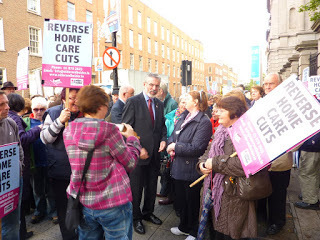
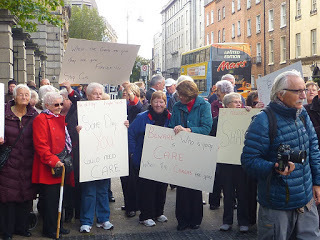
Published on October 23, 2012 01:04
October 19, 2012
A Border Poll is the next step
A little bit of history was made in the Seanad chamber in Leinster House last Friday. The inaugural meeting of the north south Inter-Parliamentary Association took place. Unionists and nationalists and republicans from all parts of this island rubbed shoulders and participated in the first meeting of a unique and innovative political institution that has its roots in the Good Friday Agreement.
Strand 2 of the Agreement allows for the ‘Assembly and the Oireachtas to consider developing a joint parliamentary forum, bringing together equal numbers from both institutions for discussions of matters of mutual interest and concern.’
Later in October 2006 agreement was reached at St. Andrew’s in Scotland which saw the re-establishment of the Executive and Assembly the following May. And once again it was agreed that a North-South parliamentary forum would be established.
George Mitchell memorably told me and Martin McGuinness, after the Good Friday Agreement was achieved and he was going home, ‘that’s the easy bit. Getting it implemented will be the hardest part.’ And he was right.
Unionism has sought to minimise and delay the full implementation of the Agreement ever since. There has been considerable progress but frequently the pace of change has been torturously slow and frustrating. And so it was with the north-south Inter-Parliamentary Association. It took 14 years to get to last Friday, but get there we did.
So, the Seanad chamber witnessed an equal number of MLAs from the Assembly and members from the Houses of the Oireachtas, under the Joint Chair of the Ceann Chomhairle Seán Barrett TD and the Speaker Willie Hay MLA, taking their seats as part of an arrangement that will see them meet twice a year to discuss issues of interest and concern including the economy, health, environment, energy and social issues.
This is a significant political development which should not be underestimated. It reflects the increasing acknowledgement that Ireland is too small for our people to live in isolation from each other and that working together is better for everyone.
And in that context and remembering the three days of negotiations at St. Andrew’s six years ago this month, did you notice that the meeting between the British Prime Minister David Cameron and the Scottish First Minister Alex Salmond was held in St. Andrews House in Edinburgh? They sensibly decided to call their agreement after the city and not the place!
That historic meeting saw agreement on the right of the people of Scotland to vote in a referendum on the issue of independence in 2014.
The future of the Union is now a live debating issue and firmly on the political agenda.
In the Good Friday negotiations Sinn Féin secured the removal of the Government of Ireland Act under which the British government claimed sovereignty over the north of Ireland. There is now only a qualified, conditional claim that will change when a majority of citizens in the north vote for an end to the union.
In the Constitutional Issues section of the Good Friday (or Belfast) Agreement (1.iv) the British and Irish governments:
“affirm that, if, in future, the people of the island of Ireland exercise their right of self-determination on the basis set out in sections (i) and (ii) above to bring about a united Ireland, it will be a binding obligation on both governments to introduce and support in their respective Parliaments legislation to give effect to that wish”
Sections (i) and (ii) referred to are the requirement for the consent of a majority within the North and the provision for concurrent referenda North and South.
The Good Friday Agreement therefore provides for a border poll on Irish unity. This commitment was incorporated in the British Northern Ireland Act 1998 (Schedule 1) which states that: “The Secretary of State may by order direct the holding of a poll for the purposes of section 1 [of the Act re. Irish unity] on a date specified in the order.”
I raised this issue with the Taoiseach during Leaders Questions in the Dáil on Tuesday. I welcomed his comment last week in Cleveland in the USA where he had expressed the opinion that a united Ireland will happen ‘one day.’
Predictably, Gregory Campbell rushed to condemn Kenny. But his position was not shared by an online poll in the Belfast Telegraph which produced 46% supporting the Taoiseach’s view that a united Ireland will happen.
However, I put it to the Taoiseach that there is a need to go beyond the rhetoric. Uniting Ireland is one of the great historic challenges facing the Irish people at the start of the 21st century.
The people of this island have the right to independence and self-determination. Partition is unjust, uneconomic and inefficient.
But a united Ireland will only happen when those of those who want it persuade those who don’t that it will be better for them and for their children. It needs a plan, a strategy. We have to demonstrate in practical ways why working as partners and living together as equals on this island is better.
So I called on the Taoiseach to come back to the Dáil in the next short while with an outline of how he envisages securing the full implementation of the Good Friday Agreement and a border poll.
Not surprisingly the Fine Gael leader looked for excuses to do nothing at this time. He argued that it isn’t the right time for this debate and that the Irish government has to sort out the economy first.
This is entirely the wrong approach. Now is exactly the right time for a debate on this issue in the context of rebuilding the economies on this island and beginning a process of dialogue and reconciliation around Irish unity.
The Good Friday Agreement allows for a border poll. It must be the next step.
Published on October 19, 2012 04:06
October 12, 2012
Creating Jobs – it isn’t rocket science!
Last month the Central Statistics Office produced new emigration figures for the southern state which revealed that 87,000 people had moved to Australia and Canada and other far corners of the globe. The reason? There is no work at home. Currently 460,000 citizens are on the live register. That’s over 14%. And government policies are making the situation worse – not better.Thousands of home owners are trapped in negative equity; poverty is increasing and government debt now stands at €169 billion. Fine Gael and Labour are committed to an austerity strategy which is pushing up unemployment and driving down the quality of life of families.
They have bought into a political and economic strategy which has seen the state’s economic sovereignty dangerously undermined and the introduction of a succession of punitive measures that have reduced wages, child benefit payments, disability payments and social welfare; and attacked social provisions for carers, older citizens, and the blind. In addition a range of stealth taxes, including the Household charge; the universal social charge; VAT increases; septic tank charges and more have eaten dramatically into the incomes of families.Thursday saw the Taoiseach tell the Trade Unions at a meeting of the Croke Park implementation body that there have to be significant payroll cuts next year. He also warned that there could be no delay in reaching agreement and pointed to the negotiations with the hospital consultants as an example of what can be achieved.
The problem is that the words were barely out of his mouth when it emerged that negotiations between the two bodies representing the consultants and the Health Service Executive on work practices had broken down and the issue would now most likely end up in the Labour Relations Court.
Sinn Féin believes that the Irish government is making the wrong choices and disproportionately placing the burden of paying for the debts of the golden circles on those who can least afford it.Unemployment hurts citizens, drives families into poverty and despair, leads to increased numbers of suicide, the loss of the family home, and social problems for communities.
It drives many of our brightest and best young people to flee to Australia and other parts of the globe.In response to this Sinn Féin has in recent years produced a series of alternative budget proposals, in advance of the annual December budget, that contain practical, effective and innovative proposals to reduce the deficit, create growth in the economy, get people back to work and target youth unemployment.
Like our Wealth Tax proposal these are socially responsible proposals. It is evidence that in the battle of ideas that the Sinn Féin party is prepared to think outside the box in seeking effective solutions to problems.Austerity means cuts. It means reducing public spending by attacking public services. It has been a mantra of Sinn Féin that you cannot cut your way out of recession.
And like our alternative budget proposals, Sinn Féin on Thursday produced an alternative jobs creation strategy. Politics is about political choices and in our Jobs Plan Sinn Féin has produced a fully costed, detailed plan that provides a socially responsible way to reduce the budget deficit while creating and retaining jobs. It calls for an investment of €13 billion into job creation and retention, which will create an average of 156,000 short and long term jobs.
The money is there; in the National Pension Reserve Fund, the European Pension Bank, the private pension sector, and in the money the government plans to cut from its capital budget spend.
This is not rocket science.The scandal is that this government will continue to fritter away the money in the NPRF; put money into toxic banks, and pay off unguaranteed bondholders, while older citizens lose home care supports, and there is one reduction after another in wages; support for lone parents; carers; citizens with disabilities; the blind and the unemployed.
Fine Gael and Labour have no strategic vision of how to invest the money in the National Pension Reserve Fund in a way that can help the economy in the long term.Sinn Féin has a strategy.
It is a thoughtful, rational, well developed and costed plan that will use the available resources in an intelligent – smart way.There will be those who disagree with our proposals. That’s fine. Let them do so constructively and provide their alternative.
What we will not tolerate is the begrudgery that passes for political discourse from Fine Gael and Labour. Their record, like that of Fianna Fáil, is appalling.Remember Fine Gael’s manifesto promised that their NewERA plan would invest an extra €7 billion in energy, communications and water to give Ireland the world class infrastructure?
There was to be a Jobs Budget within 100 days of the Government being established but this was watered down to a Jobs initiative in May 2011.
In February of 2012, after a year in office the Government unveiled an Action Plan for Jobs. At its lunch the Taoiseach said it would create an additional 100,000 jobs.
There has been a loss of 33,000 in the last year.
Remember the Labour Party’s promise before the election that it would put in place a €500 million jobs fund to support new ideas and create employment in strategic sectors of the economy?
They promised to establish a strategic investment bank, with a lending capacity of €2 billion, from the National Pension Reserve Fund.
None of this happened. And then there was the Strategic Investment Fund unveiled in September 2011.
It was to provide funds from the National Pension Reserve Fund for investment in the economy, provide capital for small and medium enterprises and the creation of jobs.
Last week in the Dáil the Taoiseach still couldn’t say when the legislation required for the Fund would be produced by his government.
The reality is that none of this is real or meaningful because the government is ideologically locked into an austerity approach that is about cutting jobs and funding from the public sector, and is driving down growth through stealth taxes.
If you want to cut the deficit and increase government revenue while reducing its expenditure, particularly its social welfare bill, then you have to stimulate the economy, reduce unemployment and generate growth.Sinn Féin’s Jobs Plan will do what all of that failed to achieve. It can create real jobs, using real money, and provide the essential growth and stimulus that the economy needs to overcome the disastrous effects of successive bad policies by this government and the last.
Published on October 12, 2012 02:32
October 8, 2012
Slavery and the Magdalene laundries
Did you know that there are an estimated 27 million slaves in the world today? I didn’t. Many are forced labourers and soldiers – many of them children – coerced, sold, traded into involuntary service and over half of forced labourers and almost all of sex trafficking victims are women and young girls.
In the language of the 21st century the word slavery has been largely replaced with the term human trafficking or trafficking in persons. But it is still slavery. It takes many forms from sexual exploitation, forced labour in sweat shops and factories, to debt bondage. And modern slavery is not confined to the developing world. Trafficking in persons is a serious problem in the developed world. According to statistics from the US State department at least 14,500 people are trafficked into the USA every year.
For many the notion of slavery is linked to the slave ships that plied their trade across the Atlantic between Africa and the USA; and the American Civil War that freed the slaves but didn’t bring freedom or equality or justice for many generations.
There were Irish slaves too. Thousands were sold by the British in the 17thcentury to the plantations in the Caribbean while many more were indentured servants – little better than slaves.
But the realisation that slavery today is a world-wide phenomenon that continues to exist in many countries is a surprise.
Each year I attend the Clinton Global Initiative conference in New York run by former President Bill Clinton. And each year the issue of human trafficking and in particular of women and young girls, and the conditions of their employment and exploitation as sex workers, is the subject of debate. I was there two weeks ago and this issue was given added weight on the final day of the CGI in a speech by President Obama who dedicated his entire remarks to the issue of modern slavery.
He said: “When a man, desperate for work, finds himself in a factory or on a fishing boat or in a field, working, toiling, for little or no pay, and beaten if he tries to escape -- that is slavery. When a woman is locked in a sweatshop, or trapped in a home as a domestic servant, alone and abused and incapable of leaving -- that’s slavery. When a little boy is kidnapped, turned into a child soldier, forced to kill or be killed -- that’s slavery. When a little girl is sold by her impoverished family -- girls my daughters’ age -- runs away from home, or is lured by the false promises of a better life, and then imprisoned in a brothel and tortured if she resists -- that’s slavery. It is barbaric, and it is evil, and it has no place in a civilized world.”
On the same day that Obama made his remarks Sinn Féin introduced a Private Members Motion into the Dáil to help the victims of a form of slavery that for many decades passed unnoticed in the Irish state and which even today this Irish government is failing to deal with properly.
The Magdalene asylums first opened their doors in Ireland approximately 200 years ago. They were first run by Protestant orders initially seeking to ‘rehabilitate’ prostitutes. The institutions were taken over by four Catholic religious orders. Over time the state increasingly used these institutions as a place to deal with a multitude of social problems including, poverty, disability, so-called immoral behaviour, babies born out of wedlock, domestic and sexual abuse, youth crime, and infanticide. The religious orders in turn used these girls and women as unpaid labour. The last operating laundry closed its doors on Sean McDermott Street in 1996 with 40 women still in residence, the eldest of them 79, the youngest in her 40s.
Women incarcerated in these institutions worked for no pay whilst the orders ran the laundries on a commercial basis in brutally harsh conditions. There were 10 laundries in Dublin, Waterford, Limerick, Cork, Galway and Wexford. The State provided direct and indirect financial support to the Laundries.
The Ryan Report (2009) details the women’s forced unpaid labour in the Laundries and states that their working conditions were harsh, they were completely deprived of their liberty and suffered both physical and emotional abuse. Those who tried to escape and were caught by the Garda were returned to the institutions.The Magdalene women were excluded by the State from the 2002 Residential Institutions Redress Scheme established to pay victims of abuse in Church run institutions like the industrial school system primarily on the basis that the laundries were privately run and it claimed it therefore had to involvement in the institutions.
In June 2011the government set up an interdepartmental Committee into the Magdalene Laundries for the purpose of clarifying any State interaction with the Magdalene Laundries. Senator Martin McAleese was appointed chair of the Committee. His final report was due in July but the deadline for its publication is now the end of the year.The Sinn Féin motion was intended to support the work of the McAleese committee and to persuade the government to take steps now to alleviate some of the trauma still being suffered by these women all of whom are elderly.
But more immediately the motion was about getting the government to establish a helpline for the women and commit it to support survivors in accessing pensions that they are entitled to for all their years of hard and painful work without pay in the laundries. In opposition both Labour and Fine Gael criticised the Fianna Fáil Government for excluding both the Magdalene Laundries and Bethany Home from the redress scheme. In government Labour and Fine Gael are hiding behind the McAleese report to do nothing.
Worse in their defence of the government’s amendment to the motion, which they forced through on a vote, they questioned the established facts surrounding the treatment of the women. Labour Minister Kathleen Lynch said she did not doubt the sincerity of the women or ‘have sympathy with them for the hardships they faced and endured’ but then did exactly that by arguing that the state ‘cannot leap to conclusions’.
‘The facts remain undetermined’ said Minister Kathleen Lynch.Not true. The facts are well known and have been graphically presented in previous reports, including some by international agencies; by the survivors and in a recent report produced by Justice for the Magdalenes.
These women endured slavery and successive Irish governments colluded in this. That was shameful. But it is even more dishonourable that this government should fail to resolve this issue and chose instead to add hurt to the victims by doubting their veracity. Finally, I recently read a poem by Maya Angelou. It relates to the slavery of black people but isn’t exclusive to them. It says so much about the courage and heroism of those of whatever colour who resist slavery and determine to rise above it. As I read it I thought of the women and girls of the Magdalene laundries.
You may write me down in history
With your bitter, twisted lies,
You may trod me in the very dirt
But still, like dust, I'll rise.
Does my sassiness upset you?
Why are you beset with gloom?
'Cause I walk like I've got oil wells
Pumping in my living room.
Just like moons and like suns,
With the certainty of tides,
Just like hopes springing high,
Still I'll rise.
Did you want to see me broken?
Bowed head and lowered eyes?
Shoulders falling down like teardrops.
Weakened by my soulful cries.
Does my haughtiness offend you?
Don't you take it awful hard
'Cause I laugh like I've got gold mines
Diggin' in my own back yard.
You may shoot me with your words,
You may cut me with your eyes,
You may kill me with your hatefulness,
But still, like air, I'll rise.
Does my sexiness upset you?
Does it come as a surprise
That I dance like I've got diamonds
At the meeting of my thighs?
Out of the huts of history's shame
I rise
Up from a past that's rooted in pain
I rise
I'm a black ocean, leaping and wide,
Welling and swelling I bear in the tide.
Leaving behind nights of terror and fear
I rise
Into a daybreak that's wondrously clear
I rise
Bringing the gifts that my ancestors gave,
I am the dream and the hope of the slave.
I rise
I rise
I rise.
Published on October 08, 2012 13:06
October 5, 2012
Breast Cancer Awareness month
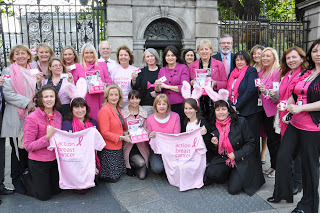
For over two decades October has been designated Breast Cancer Awareness month around the world. The pink ribbon or the wearing of pink has become synonymous with the campaign to raise awareness of this dreadful disease. On Thursday morning Martina Anderson MEP, who was in Dublin for the visit of the European Parliament President Martin Schulz, and I joined other colleagues from the Oireachtas and activists from the Irish Cancer Society outside Leinster House. We were there to add our voices to the efforts of the Irish Cancer Society and Action Breast Cancer, and Action Cancer in the north and many other fine organisations who are involved in raising awareness about breast cancer. I was there also to say thank you for their commitment and dedication.
This year the Irish Cancer Society has organised a new kind of pink initiative. It’s called ‘Get the Girls, www.getthegirls.ie– and its goal is to raise even more money than in previous years for breast cancer services and research.
Over 4000 new cases of breast cancer are diagnosed each year across the island of Ireland. According to Breast Cancer Ireland‘it is the most common invasive cancer in Irish women.’ Around 40 of these or 1% will be men. In the south over 600 women die each year from breast cancer while the figure for the north is around 300.
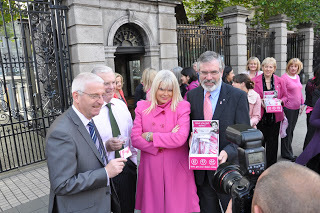
However it is also true that while the incidence of breast cancer has not dropped the number of women dying as a result has. Early detection and treatment is the key to survival. That means raising awareness among women and men about breast cancer to persuade everyone to check their breasts and to seek help if they have a concern.
Last week Breast Cancer Ireland launched its free Breast Aware iphone app. This will ensure that women receive a discreet monthly reminder to their phone and a step by step guide as to how to perform a self breast exam. You can download the app by going to iTunes http://itunes.apple.com/us/app/breast...
If you have a concern visit your doctor or go onto the many websites where it’s possible to get information. For example: www.actioncancer.org, tel nos 02890803344; and www.cancer.ie, Freephone 1800200700. Talk to someone. Get the Irish Cancer Society’s exhaustive directory of cancer support services.
The Irish Cancer Society and Action Cancer run extensive breast screening services which have saved many lives. They have also raised significant amounts of money to improve the outcome for patients and for research. They deserve our full support.
Finally, I cannot write about breast cancer without writing about my friend and comrade Siobhan O Hanlon. In October 2002 Siobhan was diagnosed with breast cancer. And for the next three and a half years she battled it every single day.
Siobhan was a very private person but in September of the following year, and as part of that October’s Breast Awareness month she planned and organised a conference on the issue at the Belfast Institute for Further and Higher Education on the Whiterock Road in west Belfast.
The conference was a way of bringing community activists and others together to talk about this issue and to raise awareness. It was also about drawing public attention to the mobile screening units that Siobhan had successfully lobbied Action Cancer to bring into west Belfast.
So focused was Siobhan on this issue that for once she set aside her natural reticence to speak publicly and addressed the audience about her experience.
She told of getting the news that she had cancer and of the approach taken by the hospitals; of having her breast removed, and of discovering that the cancer was aggressive.
It was one of the most moving contributions I have ever heard. I have no shame in saying that I cried at the end of it. It was typical Siobhan. Honest and frank. She described how when you have cancer there are a number of big days. And she talked of these.
She included the day when she lost her hair. At one point she said: ‘I was a mess. I had no hair, no eyebrows. No eye lashes, one breast. My nails were all broken. I was tired. I knew I had to get my act together. My hair had stated to grow but it was very slow. It was also terrible grey.’
She described how there are ‘three terrible days in relation to your hair.’ They are, she said: ‘1. when your hair starts coming out, 2. when you put a wig on for the first time, and 3. when you have to take it off again. That was an awful day. I remember going into the office and this guy was going across the top of the stairs. He said ‘Ah, Siobhan’. ‘Don't open your mouth’ I told him. ‘I have more hair than you’. And I did!’Siobhan died in April 2006. But her courage and determination and example is a constant reminder to me that whatever can be done to raise awareness about this awful disease must be done, and whatever help can be given to provide support services for cancer patients must be given.
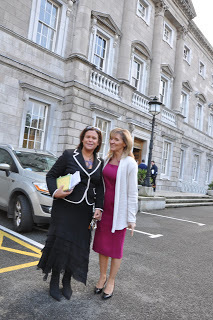
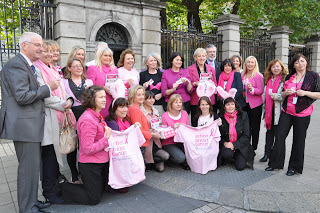
Published on October 05, 2012 09:49
October 1, 2012
Remembering An Gorta Mor
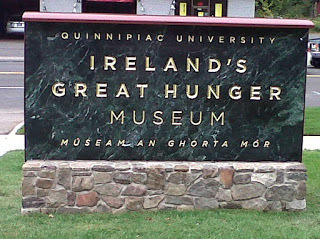
‘We perish houseless, naked, starved, with branded brow,
Dying, dying wearily, with a torture sure and slow –
Dying as a dog would die, by the wayside as we go.’
These are the words of the Irish poet Speranza – Lady Jane Wilde, the mother of Oscar – who was a regular contributor to the Young Irelanders publication The Nation and who recorded her testimony in verse in early Black 47 of the human cost and impact of An Gorta Mór – the Great Hunger.
Last week I was invited by John Lahey, the President of Quinnipiac University in Hamden Connecticut, to give a talk on the issue of the great hunger. I was at the university in 2003 and at that time under John’s stewardship they had already compiled a unique collection of art and research and resource materials on that period of Irish history.
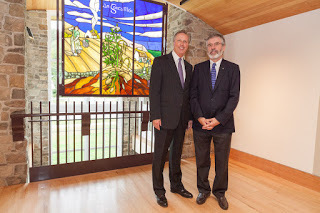
John Lahey and I in front of Robert Ballagh's powerful piece
The collection has grown significantly since then and last week saw the official opening of Múseam an Ghorta Mór – Ireland’s Great Hunger Museum.
It is a measure of the determination of President Lahey and his colleagues to create the world’s leading educational and research resource and art collection on this subject.
It is also a hugely significant and invaluable new addition to the efforts of academics and historians and others to tell and understand the history of Ireland and in particular the tragedy of An Gorta Mór.
I was given a private tour of the Museum two days before its official opening. It contains art work and sculptures from the 19th and 20th and 21st centuries from some of Ireland foremost artists – Daniel McDonald, John Behan, Rowan Gillespie, Lillian Lucy Davidson, Robert Ballagh, Brian Maguire, Michael Farrell, Paul Henry, Margaret Allen and others.
The imagery and colours and stories they tell evoke a great sense of sadness at the grief and pain and trauma and loss so many suffered during the so-called famine years and subsequently.
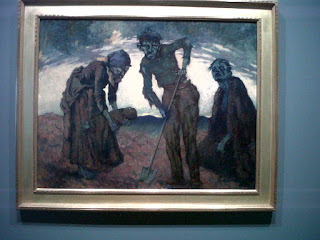
'Burying the Child'
As you walk up the stairs to the first floor you are confronted by Lillian Lucy Davidson’s ‘Burying the Child’. Hopelessness and emptiness are etched on their faces. It is a striking emotive piece.
Another Connecticut connection reminds us of the horror of the hunger. Elihu Burritt described a soup kitchen which was surrounded by ‘famine spectres, half naked and standing or sitting in the mud … struggling forward with their rusty tin and iron vessels for soup, some of them upon all fours, like famished beasts’.
In a graveyard he found a tiny shed that ‘served as a grave where the dying could bury themselves … [where] living men, women and children went down to die; to pillow upon the rotten straw, the grace clothes vacated by preceding victims and festering with their fever. Here they lay as closely to each other as if crowded side by side on the bottom of one grave.’
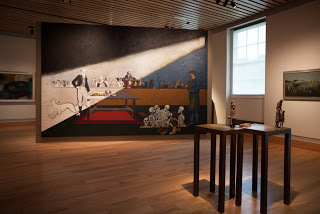
Black 47
A large canvas - ‘Black 47’ by Michael Farrell – imagines Charles Trevelyan, the assistant secretary to the British treasury and the man responsible for the British government’s relief policy, on trial for his actions. Trevelyan described the tens of thousands dying as a ‘mechanism for reducing surplus population’ and ‘the direct stroke of an all-wise Providence’.
Trevelyan’s cruelty is immortalised the ‘The Fields of Athenry’:
By a lonely prison wall,
I heard a young girl calling
Michael, they are taking you away,
For you stole Trevelyan’s corn,
So the young might see the morn,
Now a prison ship lies waiting in the bay.
In a glass case on the first floor of the museum there are books recording the events of 1845-51 – including reports from the British Parliament and from the Mansion House Committee established by Daniel O Connell and others to record the impact across the island. Among these are letters to the Cork Examiner which had been established only four years before the blight struck.
In a letter to the editor written by Jeremiah O Callaghan from Bantry Abbey wrote:
Sir, on entering the graveyard this day, my attention was arrested by two paupers who were engaged in digging a pit for the purpose of burying their fellow paupers; they were employed in an old ditch. I asked why they were so circumscribed; the answer was ‘that green one you see on the other side the property of Lord Berehaven. His stewards have given us positive directions not to encroach on his property, and we have no alternative but this old ditch; here is where we bury our paupers’.
I measured the proud – it was exactly 40 feet square and contained according to their calculation 900 bodies. They then invited me to come and see a grave close by. I could scarcely endure the scene. The fragments of a corpse were exposed, in a manner revolting to humanity; the impression of a dog’s teeth was visible. The old clothes were all that remained to show where the corpse was laid’. June 1847
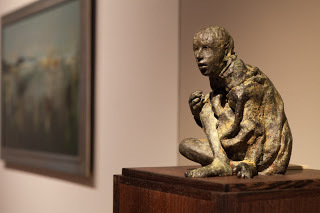
The Victim
The first piece bought by John Lahey and which he carried from Ireland 14 years ago is a bronze entitled ‘The Victim’. It’s by Rowan Gillespie and is intended to represent each of the millions who died or fled.
The museum and the research material in the university are an invaluable resource for anyone wishing to understand that period of Irish history, the phenomenal growth and influence of the diaspora, and the shaping of modern Ireland.
The Quinnipiac collection provides the political and social context of this human calamity, of the decisions taken by the British government and of the catastrophic consequences for the Irish people.
I believe you cannot understand anything of Irish history, whether in the 1840s or in more recent decades, unless you set it in the context of the English invasion, colonisation and partition of Ireland – and no single event illustrates this fact more than An Gorta Mór.
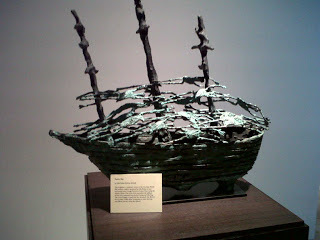
A Coffin Ship
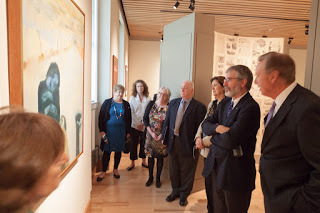
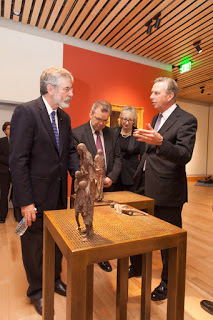 With Niall O Dowd and John Lahey
With Niall O Dowd and John Lahey
Published on October 01, 2012 11:16
September 25, 2012
Following in the footsteps of Connolly
I am in New York this week for the annual Clinton Global Initiative event. It is the 8th year of the CGI and in that time it has raised billions of dollars for underdeveloped and struggling nations around the world, as well as investing in projects in more developed countries aimed at creating jobs, improving the environment and promoting education and health
This week the CGI is bringing together more than 1,000 people from the world of politics and business and community. It includes current and former heads of state as well as NGOs, business and community leaders. Its focus this year is on designing solutions to empower girls and women to be full participants in the global economy, to spur development, and improve global health and technology.
The idea behind the CGI is simplicity itself. To provide a location where business leaders, politicians, non-governmental organisations, activists and representatives of charitable foundations, can come together, talk about issues affecting people around the world and then make partnerships and commitments to take actions than can alleviate poverty or provide health care or education or water or sanitation and much more.
But as well as attending the Clinton conference on Monday night I was the guest speaker at a celebration of Irish America’s contribution to the Trade Union Movement organized by the Irish Echo.
It was an excellent event honouring the dedication and commitment of 50 Irish American trade unionists. Speaker after speaker referred with pride to their Irish heritage and all deferred to the activism and example of James Connolly.
The Irish in America, as well as elsewhere around the world - in Canada, in Britain and Australia - have played a significant role in building the trade union movement. The importance of and the role of trade unions in defending the rights of working people cannot be overstated.
This is especially true at this time when in the midst of a world-wide economic recession there are those arguing for strategies and policies that are about cutting wages and sacking and undermining workers’ rights and protections.
These conservative and right wing elements see the recession as an opportunity to increase profits irrespective of the social and human cost. The trade union movement has to be in the frontline battling that strategy.
It is important to remember that it is only a matter of a few generations ago that workers’ had no rights whatsoever. They were hired and fired at the whim of unscrupulous employers. The children of workers had no childhood and little hope of a future. They too worked from a young age.
In the Belfast of the 19th and early 20th centuries the linen mill-workers lived under the shadow of the mills where they worked. Female and child labour predominated. Children, mostly girls, worked the same hours as adults. But the children were called half-timers. They worked three days one week (Monday, Wednesday and Friday) and went to school on Tuesday and Thursday. The following week it was the reverse and they did this until they were 14.
They lived in appalling conditions. The greater number of these workers died before the age of forty-five. Children generally were badly developed and small.
The great American writer Jack London’s description of a child worker was equally applicable in the USA or in Belfast at that time; ‘He did not walk like a man. He did not look like a man. He was a travesty of the human.
It was a twisted and stunted and nameless piece of life that shambled like a sickly ape, arms loose-hanging, stoop shouldered, narrow-chested, grotesque and terrible.’
One answer to this misery and exploitation was the establishment of workers federations, craft unions and trade unions. Workers combining together to use their collective strength in common cause to achieve better conditions, decent wages and a better future for them and their families.
Trade unions were frequently outlawed, their right to strike suppressed and many have been killed and imprisoned and victimized. Sometimes unions have won a battle for recognition or better wages and conditions and sometimes they have lost. But they have never given up!
One such dark period in trade union history will be marked next year in Ireland when we commemorate the 100 anniversary of the Dublin Lock-out. That experience exemplifies much of what workers and trade unions here also faced at that time.
Every day Trade unionists confront and combat inequality. Every day anti-union laws are advocated. Every day trade unionists strategise and plan and campaign to ensure their members have decent health care and insurance; safe working conditions; decent wages and security from exploitation.
Multi-nationals, and those who advocate globalisation, are in the business of making a profit over workers rights and entitlements.
A few years ago I addressed the Transport Workers Union local 100 surrounded by banners proclaiming the contribution of Connolly to Trade Unionism in the United States and Canada.
Connolly spent 7 years of his life here in the United States where he helped found and organise the Independent Workers of the World and campaigned tirelessly for workers rights.
Connolly understood the connection between Irish freedom from Britain and the rights and freedoms and future prosperity of workers. His great slogan, ‘The cause of Labor is the cause of Ireland; the cause of Ireland is the cause of labor’ is as relevant today as it was when he first penned it.
Today in many places there are laws defining and protecting workers rights. But there is still a battle to be won in many parts of the world to introduce legislative protections for workers.
Everywhere workers rights have to be constantly defended. That is the primary role of the trade union movement. But it is also a duty for everyone who cherishes citizens rights. Workers rights and citizens rights – human rights – are indispensible.

This week the CGI is bringing together more than 1,000 people from the world of politics and business and community. It includes current and former heads of state as well as NGOs, business and community leaders. Its focus this year is on designing solutions to empower girls and women to be full participants in the global economy, to spur development, and improve global health and technology.
The idea behind the CGI is simplicity itself. To provide a location where business leaders, politicians, non-governmental organisations, activists and representatives of charitable foundations, can come together, talk about issues affecting people around the world and then make partnerships and commitments to take actions than can alleviate poverty or provide health care or education or water or sanitation and much more.
But as well as attending the Clinton conference on Monday night I was the guest speaker at a celebration of Irish America’s contribution to the Trade Union Movement organized by the Irish Echo.
It was an excellent event honouring the dedication and commitment of 50 Irish American trade unionists. Speaker after speaker referred with pride to their Irish heritage and all deferred to the activism and example of James Connolly.
The Irish in America, as well as elsewhere around the world - in Canada, in Britain and Australia - have played a significant role in building the trade union movement. The importance of and the role of trade unions in defending the rights of working people cannot be overstated.
This is especially true at this time when in the midst of a world-wide economic recession there are those arguing for strategies and policies that are about cutting wages and sacking and undermining workers’ rights and protections.
These conservative and right wing elements see the recession as an opportunity to increase profits irrespective of the social and human cost. The trade union movement has to be in the frontline battling that strategy.
It is important to remember that it is only a matter of a few generations ago that workers’ had no rights whatsoever. They were hired and fired at the whim of unscrupulous employers. The children of workers had no childhood and little hope of a future. They too worked from a young age.
In the Belfast of the 19th and early 20th centuries the linen mill-workers lived under the shadow of the mills where they worked. Female and child labour predominated. Children, mostly girls, worked the same hours as adults. But the children were called half-timers. They worked three days one week (Monday, Wednesday and Friday) and went to school on Tuesday and Thursday. The following week it was the reverse and they did this until they were 14.
They lived in appalling conditions. The greater number of these workers died before the age of forty-five. Children generally were badly developed and small.
The great American writer Jack London’s description of a child worker was equally applicable in the USA or in Belfast at that time; ‘He did not walk like a man. He did not look like a man. He was a travesty of the human.
It was a twisted and stunted and nameless piece of life that shambled like a sickly ape, arms loose-hanging, stoop shouldered, narrow-chested, grotesque and terrible.’
One answer to this misery and exploitation was the establishment of workers federations, craft unions and trade unions. Workers combining together to use their collective strength in common cause to achieve better conditions, decent wages and a better future for them and their families.
Trade unions were frequently outlawed, their right to strike suppressed and many have been killed and imprisoned and victimized. Sometimes unions have won a battle for recognition or better wages and conditions and sometimes they have lost. But they have never given up!
One such dark period in trade union history will be marked next year in Ireland when we commemorate the 100 anniversary of the Dublin Lock-out. That experience exemplifies much of what workers and trade unions here also faced at that time.
Every day Trade unionists confront and combat inequality. Every day anti-union laws are advocated. Every day trade unionists strategise and plan and campaign to ensure their members have decent health care and insurance; safe working conditions; decent wages and security from exploitation.
Multi-nationals, and those who advocate globalisation, are in the business of making a profit over workers rights and entitlements.
A few years ago I addressed the Transport Workers Union local 100 surrounded by banners proclaiming the contribution of Connolly to Trade Unionism in the United States and Canada.
Connolly spent 7 years of his life here in the United States where he helped found and organise the Independent Workers of the World and campaigned tirelessly for workers rights.
Connolly understood the connection between Irish freedom from Britain and the rights and freedoms and future prosperity of workers. His great slogan, ‘The cause of Labor is the cause of Ireland; the cause of Ireland is the cause of labor’ is as relevant today as it was when he first penned it.
Today in many places there are laws defining and protecting workers rights. But there is still a battle to be won in many parts of the world to introduce legislative protections for workers.
Everywhere workers rights have to be constantly defended. That is the primary role of the trade union movement. But it is also a duty for everyone who cherishes citizens rights. Workers rights and citizens rights – human rights – are indispensible.
Published on September 25, 2012 04:33
September 18, 2012
Liberty, Equality, Fraternity
For much of the media the summer is the political silly season. It’s a time when they fill column inches and news reports with fluff and nonsense.
For the people of north Belfast the summer was far from silly. This year’s orange marching season and the blatantly sectarian actions of some orange bands as they passed St. Patrick’s Church in Donegal Street; the behaviour of the orange order at Ardoyne; the UVF fuelled attacks on the PSNI around Carlisle Circus; and the defence of all this by leading unionist politicians, was a reminder of the undercurrent of sectarianism which remains a major problem in the north.
South of the border the disastrous health policies of the Irish government, and their impact on health provision and hospital services, has seen growing public dissatisfaction with that government. This was brought into sharp focus when the HSE announced cuts of €130 million in August. There was immediate and vocal public outrage at its proposal to cut the personal assistant allowance for disabled people. Seven people with disabilities and several carers picketed Government Buildings, staying overnight in protest at the threatened cuts.
The Health Minister was forced into a u-turn. However, Minister Reilly said that while the government would try to maintain existing services he could not guarantee that the upcoming budget would not include cuts around disability.
This and Minister Brian Hayes remarks at the weekend that some wealthy pensioners should pay more has heightened fears around the budget. Government Ministers indulged in the scare tactics this time last year.
At the same time as Ministers are openly talking about December’s budget the Taoiseach Enda Kenny and Labour leader Eamon Gilmore have been refusing to answer questions on it or to speculate about the content of the budget other than to say that it will be ‘savage’.
This will be this government’s second budget and it will see the imposition of almost another three and a half billion euros in cuts and taxes. It is effectively planning to take a kango hammer to the public services.
The madness of this approach is evident in the fact that AIB, which is owned by the state, will hand over €1 billion to unguaranteed bondholders on October 1st. This is almost one third of what will be cut in December’s budget!!
While Sinn Féin agrees that the state has to cut its debt and deficit we believe its approach to achieving this is wrong and deeply flawed and isn’t working. It is making the wrong choices and taking the wrong decisions.
Sinn Féin’s approach in the north, where we are in a mandatory coalition government with unionist parties that are deeply conservative, or in the Dáil where we are the lead opposition party, is about defending working people from the worst excesses of Tory government policies and opposing the punitive policies of Fine Gael and Labour.
Our policies are framed by our core republican values. These are about freedom and Irish unity, and equality and citizens’ rights, including the right to a home, to a job, to a decent standard of health care, to a clean environment and social solidarity. Liberty, Equality and Fraternity.
On Monday we held a planning day in Dublin with our 17 strong Oireachtas team and Leinster House support team. The all-day session took place in Clasac, the Comhaltas Ceoltóirí Éireann resource centre in Clontarf which is a very fine building. Our purpose was to discuss our strategy for the new term of the Dáil which began on Tuesday. We were joined by Deputy First Minister Martin McGuinness and key support staff from the north.
The reality is that we have two states on this island which since partition have evolved different systems. It is important therefore that we have a joined up approach. This is particularly pertinent as London still exercises fiscal control in the north. This is deeply frustrating as it limits the Executive’s ability to challenge the imposition of some measures which are still in the provenance of the British.As a result of work ongoing at this time Sinn Féin will shortly be launching a major jobs strategy for the 26 counties which we believe can create more than 150,000 jobs while retaining thousands of current jobs. This can be paid for from a €13 billion additional investment in job creation and economic growth over the next four years. How can this be paid for at a time of recession?
It would be funded from €5.8billion in discretionary funding in the National Pension Reserve Fund, €1.534billion from the European Investment Bank, €3 billion incentivised investment from the private pension sector and we would not cut the €2.6 billion which the government cut from it’s capital budget spend.
Following months of intensive conversation with rural communities across the island, involving Martin Ferris TD, Senator Trevor Ó Clochartaigh, Senator Kathryn Reilly and myself, Sinn Féin will also be publishing a new document setting out proposals for the regeneration of rural Ireland with a particular focus on the west.
And in November, in advance of the Fine Gael/Labour budget Sinn Féin will present a fully costed, alternative – one which is fair, takes account of the hardship that people are facing and which will boost recovery.For example the government is going to bring in a property tax which will add an additional burden on households on top of previous stealth taxes like the Universal Social Charge, the Household Charge, septic tank charges, increased costs for parents with children at school, increased VAT and much more. The government claims this property tax would raise around €500 million.Sinn Féin is opposed to the property tax. We believe that those who can afford to pay more should pay more. We have consistently called for the introduction of a third rate of tax for those earning over €100,000. This would raise around €410milion. We have also argued for the establishment of a wealth tax on assets above €1million, excluding working farmland which on last years figures would raise about 800million. These measures would be far more equitable.So, there is a lot of work ahead. Sinn Féin is developing policies north and south and with an all-Ireland perspective, to meet the challenges of the here and now while planning for the future. Monday’s discussion was very useful and informative. Making progress; defending working families; opposing harsh government policies, whether from London or Dublin and advancing our objectives of unity and independence, will not happen by chance or because its right – it requires strategizing and planning and that’s what Sinn Féin is all about.
Published on September 18, 2012 08:07
September 10, 2012
We need a National Strategy to challenge Suicide
Did you know that it is estimated that every day almost 3000 people across the world take their own lives – that’s an estimated one million people every year? But the crisis goes beyond that. The World Health Organisation says that ‘for every person who completes a suicide, 20 or more may attempt to end their lives.’
Moreover, the statistics almost certainly disguise the true extent of the crisis. Prof Kevin Malone of the School of Medicine and Medical Science UCD and St. Vincent’s University Hospital gave evidence on suicide to the Dáil Joint Committee on Health and Children two years ago and reported that a study he carried out into suicide in 23 countries concluded that suicide levels are significantly higher than the official statistics suggest.
Monday was World Suicide Prevention Day. It is part of a week long international campaign to increase awareness of this issue. And it is a hugely difficult time for those families enduring the loss of a loved one.
This will be the 10th year of this concerted global effort to encourage greater research and education into suicide.
In west Belfast and Louth bereaved families and suicide awareness and prevention groups will this week be involved in a range of actions to highlight the problem of suicide in our society and the tragic impact it has on families.
In Louth SOSAD (Save our Sons and Daughters) and the M.A.D Youth Theatre Group are holding a series of events focusing on suicide. In Belfast groups like the west Belfast Suicide Awareness and Support Group and PIPS (Public Initiative for the Prevention of Suicide and Self-harm) and many others will also be doing their bit to increase public consciousness and understanding of the scale of the problem and of the support and help that exists for those who are at risk.
The human cost of suicide on families and communities in Louth and Belfast and across our society is devastating. The reality is that all sections and all generations are affected, from the very young to the very old, and for those living in rural and urban areas.
Two months ago figures from the Central Statistics Office in Dublin revealed that the number of suicides registered in the 26 counties last year was 525, an increase of 7 per cent on 2010.
It is also widely accepted that the increase in the numbers of suicides, attempted suicides and cases of self harming is directly linked to the economic depression and the stresses this is imposing on individuals and their families.
A pilot study by the National Suicide Research Foundation, published several months ago, looked at 190 deaths in Cork and revealed that almost a third of the suicide victims there worked in the construction and related businesses – the sector most affected by the economic crisis.
In the north it is a fact that those living in disadvantaged areas are three times more likely to take their lives and unemployment has an impact there too.
According to the Department of Health in Belfast over 600 people died from suicide in the two years 2010 and 2011. In 2009 West and North Belfast recorded the highest numbers of suicide in the north with 22 in the west of the City and 20 in the north.
The Public Health Agency (PHA) has recorded an increase of 64% in suicides in the first decade of the new century. 76% of all suicides in the north in 2002 were male. Six years later in 2008 this figure had increased to 77%.
Self harming is also a huge issue. Thousands are admitted to hospitals every year as a result of self-harm which in many cases go unreported. In 2008 11,700 people presented themselves at Accident and Emergency Units in the south as a result of self-harming.
While suicide and self-harming are now better understood than before, and it is accepted that suicide victims and survivors should be treated with compassion and care, the fact remains that only a small proportion of the budget is devoted to mental health.
Mental Health remains the Cinderella of the health services. This needs to be rectified.
Suicide kills more people than road accidents but tackling it does not receive the same priority.
This is an example of the failure of the health system to properly manage and resource this vitally important issue.
One way of tackling suicide and self-harm, particularly at a time of recession, would be to provide for greater co-operation between the health services north and south.
The creation of a national – all-Ireland – Suicide Prevention Agency that brings together all of those bodies and strategies involved in this issue, and has effective and dedicated funding and resourcing, would also make a major contribution to reducing the numbers who die each year.

Moreover, the statistics almost certainly disguise the true extent of the crisis. Prof Kevin Malone of the School of Medicine and Medical Science UCD and St. Vincent’s University Hospital gave evidence on suicide to the Dáil Joint Committee on Health and Children two years ago and reported that a study he carried out into suicide in 23 countries concluded that suicide levels are significantly higher than the official statistics suggest.
Monday was World Suicide Prevention Day. It is part of a week long international campaign to increase awareness of this issue. And it is a hugely difficult time for those families enduring the loss of a loved one.
This will be the 10th year of this concerted global effort to encourage greater research and education into suicide.
In west Belfast and Louth bereaved families and suicide awareness and prevention groups will this week be involved in a range of actions to highlight the problem of suicide in our society and the tragic impact it has on families.
In Louth SOSAD (Save our Sons and Daughters) and the M.A.D Youth Theatre Group are holding a series of events focusing on suicide. In Belfast groups like the west Belfast Suicide Awareness and Support Group and PIPS (Public Initiative for the Prevention of Suicide and Self-harm) and many others will also be doing their bit to increase public consciousness and understanding of the scale of the problem and of the support and help that exists for those who are at risk.
The human cost of suicide on families and communities in Louth and Belfast and across our society is devastating. The reality is that all sections and all generations are affected, from the very young to the very old, and for those living in rural and urban areas.
Two months ago figures from the Central Statistics Office in Dublin revealed that the number of suicides registered in the 26 counties last year was 525, an increase of 7 per cent on 2010.
It is also widely accepted that the increase in the numbers of suicides, attempted suicides and cases of self harming is directly linked to the economic depression and the stresses this is imposing on individuals and their families.
A pilot study by the National Suicide Research Foundation, published several months ago, looked at 190 deaths in Cork and revealed that almost a third of the suicide victims there worked in the construction and related businesses – the sector most affected by the economic crisis.
In the north it is a fact that those living in disadvantaged areas are three times more likely to take their lives and unemployment has an impact there too.
According to the Department of Health in Belfast over 600 people died from suicide in the two years 2010 and 2011. In 2009 West and North Belfast recorded the highest numbers of suicide in the north with 22 in the west of the City and 20 in the north.
The Public Health Agency (PHA) has recorded an increase of 64% in suicides in the first decade of the new century. 76% of all suicides in the north in 2002 were male. Six years later in 2008 this figure had increased to 77%.
Self harming is also a huge issue. Thousands are admitted to hospitals every year as a result of self-harm which in many cases go unreported. In 2008 11,700 people presented themselves at Accident and Emergency Units in the south as a result of self-harming.
While suicide and self-harming are now better understood than before, and it is accepted that suicide victims and survivors should be treated with compassion and care, the fact remains that only a small proportion of the budget is devoted to mental health.
Mental Health remains the Cinderella of the health services. This needs to be rectified.
Suicide kills more people than road accidents but tackling it does not receive the same priority.
This is an example of the failure of the health system to properly manage and resource this vitally important issue.
One way of tackling suicide and self-harm, particularly at a time of recession, would be to provide for greater co-operation between the health services north and south.
The creation of a national – all-Ireland – Suicide Prevention Agency that brings together all of those bodies and strategies involved in this issue, and has effective and dedicated funding and resourcing, would also make a major contribution to reducing the numbers who die each year.
Published on September 10, 2012 15:04
Gerry Adams's Blog
- Gerry Adams's profile
- 29 followers
Gerry Adams isn't a Goodreads Author
(yet),
but they
do have a blog,
so here are some recent posts imported from
their feed.



